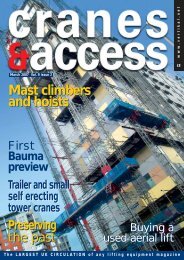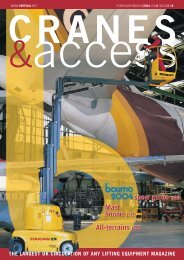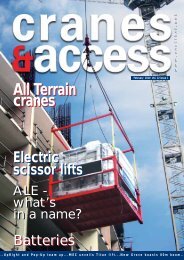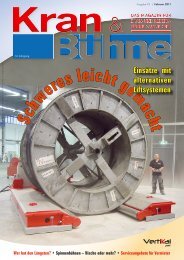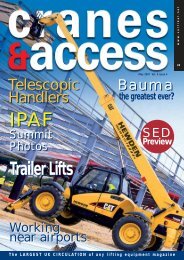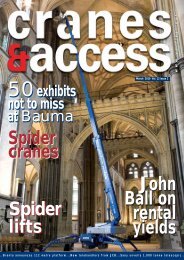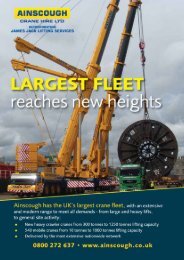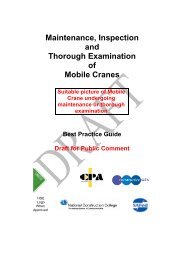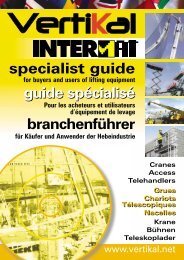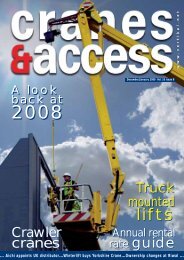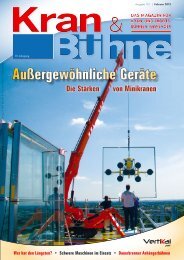You also want an ePaper? Increase the reach of your titles
YUMPU automatically turns print PDFs into web optimized ePapers that Google loves.
crawler cranes c&a<br />
AGD supplied Amec with this modified 80-tonne capacity IHI DCH800 to<br />
accommodate Amec's Soilmec RT3/ST crane attached rotary bored piling<br />
rig and a Casagrande casing oscillator for pile installation work for a<br />
bridge on the new A1/M1 link contract in Wetherby. A 35-tonne IHI<br />
CCH350 was also supplied for service duties.<br />
Earlier in the year Amec appointed AGD as its preferred supplier for all<br />
its crawler crane hire requirements throughout the British Isles. The<br />
three-year agreement covers cranes from 3 to 1000 tonnes. The larger<br />
cranes will be handled via a strategic alliance formed with Sarens UK.<br />
Economic choice<br />
According to Remo Arcangeli,<br />
senior sales manager of Manitowoc<br />
Crane Group, big crawler cranes<br />
should be the preferred choice over<br />
mobile cranes for economical reasons.<br />
“If only small capacities are<br />
required, then the advantage lies<br />
with mobile cranes,” says Mr<br />
Arcangeli. “But, today’s crawler<br />
cranes have become increasingly<br />
easier to transport and set up.”<br />
Manitowoc’s 250-tonne Model<br />
15000 complete with a 60-metre<br />
boom can be set up in less<br />
than three hours, according to<br />
Mr Arcangeli.<br />
Taking this lift height and a<br />
capacity into account when<br />
considering an equivalent mobile<br />
crane, you are looking at least a<br />
400-tonne capacity unit, so even<br />
on certain short-term operations,<br />
the crawler crane offers an<br />
economical alternative.<br />
For Glen Tellock, president of<br />
Manitowoc Crane Group, the<br />
capacity of the crane is not<br />
necessarily the issue here, rather,<br />
what the crane has to offer as a<br />
total lifting solution.<br />
“Europe, particularly in the central<br />
and northern parts, is a very tough<br />
market, but where Manitowoc<br />
stands up is by being able to offer<br />
a more customised, tailor-made<br />
crane package depending on the<br />
type of user and the work that the<br />
crane will be required to do,” he says.<br />
20 cranes & access October 2004<br />
“Applications change, so it is<br />
important that the Manitowoc<br />
product, through technology and<br />
optional features, provides the<br />
flexibility to change with them. I do<br />
not believe that one size fits all.”<br />
Earlier in the year, Manitowoc<br />
developed a new luffing jib for its<br />
136 tonne Model 555, and also<br />
an additional fixed jib, which<br />
significantly extended the<br />
maximum lift height and lifting<br />
radius of the 555 to 118.8 metres<br />
and 74.6 metres respectively.<br />
“The European crawler market is<br />
not a big one, but European<br />
customers are a little more global<br />
than in some other markets, so<br />
it is important for us to have a<br />
presence here. Traditionally, we<br />
have a very solid product with<br />
lower overall ownership and<br />
maintenance costs and a re-sale<br />
value that holds very well.”<br />
Market decline<br />
Since 1999, the European crawler<br />
market has declined by up to 70<br />
percent, but according to Mr<br />
Tellock, the market for crawlers<br />
under 150-tonnes capacity during<br />
the next 18 to 24 months will be<br />
the one to watch out for.<br />
“For larger crawlers” says Mr<br />
Tellock, “mature markets tend not<br />
to improve so much, so it will be<br />
to the opportunistic markets, such<br />
as infrastructure development<br />
within the new EU countries that<br />
crawler producers will be looking<br />
to in the future.”<br />
A Grey day in<br />
Southend-on-Sea<br />
In its November 2003 issue, C&A reported on the<br />
collapse of the jib of a Sumitomo SC350 crawler<br />
crane on a Southend job site. 12 months on,<br />
HM Inspector of Health and Safety, Gordon Crick,<br />
explains what went wrong.<br />
The incident involved a grey import crawler crane being operated without either<br />
a CE marking, or a valid Declaration of Conformity as required by the Supply of<br />
Machinery Safety Regulations 1992.<br />
An inexperienced crane dealer had imported the crane from Japan, after which<br />
time it was significantly modified and upgraded. It left the importer without indents<br />
to the hoist levers being removed, which allowed the levers to return to creep<br />
mode, rather than neutral. Also, no EC Declaration of Conformity was issued.<br />
The crane, similar to the Sumitomo crane pictured, was owned and operated by<br />
an experienced crane operator with over 40 years experience in the business.<br />
As required by the Lifting Operations and Lifting Equipment Regulations 1998, a<br />
competent person carried out a thorough examination and test of the crane and<br />
issued a certificate. However, no check was made to ensure the crane had an EC<br />
Declaration of Conformity.<br />
After import and modification the crane was used on a number of sites.<br />
On the day of the incident a qualified driver drove the crane that had six months<br />
experience operating a variety of hydraulic cranes.<br />
Following the incident, the HSE began a thorough investigation and breaches of<br />
law were identified. HSE inspectors took careful account of all circumstances<br />
relating to the incident, and decided, in line with the Code for Crown Prosecutors<br />
and the Health and Safety Commission’s Enforcement policy Statement, that<br />
prosecution action was not in the public interest. The investigation, however,<br />
exposed a number of specific failings, which the industry should take note of.<br />
These include;<br />
• The supplier failed to ensure that a technical file was prepared and did not<br />
remove the indents to the hoist levers. An EC Declaration of Conformity was<br />
not issued on the crane leaving his yard.<br />
• The crane operator should have asked for the indents to be removed and<br />
insisted on the issue of an EC Declaration of Conformity.<br />
• The crane operator should have ensured the driver had a specific handover<br />
briefing on the way this particular crane worked.<br />
• The competent person who carried out a thorough examination and test failed<br />
to check that the crane had an EC Declaration of Conformity.<br />
• Several principle contractors checked documentation for this crane,<br />
but none asked whether it carried a valid CE marking.<br />
• The individual sub-contractor hiring the crane should have checked the level of<br />
experience the crane driver had on this type of crane.<br />
• The driver of the crane should not have left the cab of his machine without<br />
going through the necessary checks to ensure it was safe to do so.<br />
This case illustrates the severe<br />
financial loss and business<br />
interruption that can result from<br />
operating machinery that does<br />
not comply with the Supply<br />
of Machinery (Safety)<br />
Regulations 1992.<br />
Importers of machinery from<br />
outside the EU, which is not CE<br />
marked and doesnot conform to<br />
the standards laid down by<br />
these Regulations must ensure<br />
that it complies before being sold, or risk investigation and prosecution under<br />
these Regulations.<br />
The industry must take this as a timely reminder that HSE will use full range<br />
of its power if there are further incidents of this type in future.



